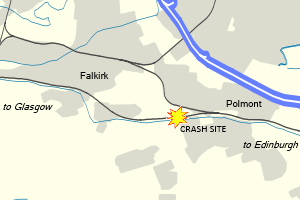
A buffer stop, bumper, bumping post, bumper block or stopblock (US), is a device to prevent railway vehicles from going past the end of a physical section of track.

Over the latter years of the 19th and early years of the 20th centuries, Penistone in Yorkshire gained a name as an accident black-spot on Britain's railway network; indeed, it could be said to hold the title of the worst accident black-spot in the country. The main line through the town was the Woodhead route of the Manchester, Sheffield and Lincolnshire Railway between Sheffield Victoria and Manchester, London Road. The line was heavily graded with a summit some 400 yards inside the eastern portal of the Woodhead tunnel.

The Polmont rail accident, also known as the Polmont rail disaster, occurred on 30 July 1984 to the west of Polmont, near Falkirk, in Scotland. A westbound push-pull express train travelling from Edinburgh to Glasgow struck a cow which had gained access to the track through a damaged fence from a field near Polmont railway station, causing all six carriages and the locomotive of the train to derail. 13 people were killed and 61 others were injured, 17 of them seriously. The accident led to a debate about the safety of push-pull trains on British Rail.
There have been a number of train accidents on the railway network of Victoria, Australia. Some of these are listed below.
The railways of New South Wales, Australia have had many incidents and accidents since their formation in 1831. There are close to 1000 names associated with rail-related deaths in NSW on the walls of the Australian Railway Monument in Werris Creek. Those killed were all employees of various NSW railways. The details below include deaths of employees and the general public.

During the afternoon rush hour of June 22, 2009, a subway train wreck occurred between two southbound Red Line Washington Metro trains in Northeast, Washington, D.C., United States. A moving train collided with a train stopped ahead of it; the train operator along with eight passengers died, and 80 people were injured, making it the deadliest crash in the history of the Washington Metro.
The Lichfield rail crash was a rail crash which occurred on New Year's Day 1946 at Lichfield Trent Valley station in Staffordshire, England. 20 people were killed in the accident, caused when a points failure routed a goods train into the back of a stationary passenger train waiting at the station. This event, alongside the Abbots Ripton rail accident, is the basis for the story The Flying Kipper in the Railway Series by Rev. W. Awdry.
The Tamworth rail crash was an accident that happened at Tamworth railway station in Staffordshire, England, on 14 September 1870. It was caused when a signalman's error accidentally diverted the Irish Mail express onto a dead end siding, where part of the train crashed through the buffers and into the River Anker. Three people were killed, and thirteen injured.
The Denver train crash occurred on 28 April 2015 when a passenger train ran into the rear of another at Denver station, Johannesburg, South Africa. One person was killed and about 240 were injured. Damages were R 17.5 million.
On 3 February 2003, a Comeng electric multiple unit train rolled away from Broadmeadows station in Melbourne, Australia, before it ran for nearly 17 kilometres (11 mi) out of control without a driver and eventually crashed into another train about to depart Spencer Street station. Train controllers attempted several times to stop or redirect the train, but were limited in their ability to intervene, instead being forced to alter the route of other trains to avert a more serious collision. Eleven people on board the stationary train were injured; authorities did not know until after the crash if any passengers were on board the runaway. An investigation identified driver error as the cause of the accident, but the runaway event prompted significant debate about the role of government authorities and private operators in ensuring safety and reliability on the Melbourne rail network.

On 4 August 2021, two passenger trains collided at Milavče in the Czech Republic. Three people were killed and 67 were injured.